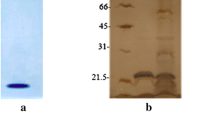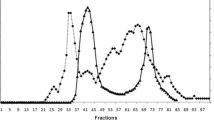Abstract
Nomuraea rileyi isolate NRRL-13755 produced a large amount of trypsin enzyme when cultured on basal salt medium containing 1% (w/v) gelatin. The trypsin was purified nearly 60-fold, with a recovery of about 13% of the initial activity from the culture supernatant. This protease exhibited a remarkably high specific activity of nearly 370,000 IU/mg protein. The native molecular weight was estimated by gel permeation chromatography to be 30 kDa, and the subunit molecular weight was determined to be about 30 kDa by sodium dodecyl sulfate-polyacrylamide gel electrophoresis (SDS-PAGE). The pH and temperature optima were determined to be 8.5 and 35°C, respectively. With a relative trypsin activity of 100%, this purified preparation showed about 10% chymoelastase and nearly 50% chymotrypsin activity. Metal-chelating agents such as EDTA and EGTA at 2mm inhibited the enzyme activity by 40%, whereas N-carbobenzoxy-glycyl-l-phenylalaninamide (CBZ-gly-phe-NH2) (2mm) and DTT (2mm) had no effect on activity. Trypsin inhibitor from turkey egg-white at 100 μg/ml strongly inhibited the enzyme activity.
Similar content being viewed by others
Literature Cited
Bidochka MJ, Khachatourians GG (1990) Identification ofBeauveria bassiana extracellular protease as a virulence factor in pathogenicity toward the migratory grasshopper,Melanoplus sanguinipes. J. Invert Pathol 56:362–370
Charnley AK (1984) Physiological aspects of destructive pathogenesis in insects by fungi: a speculative review. In: Anderson JM, Rayner ADM, Walton DWH (eds) Invertebrate-microbial interactions, Brit. Mycol. Soc. Symp. 6. London: Cambridge Univ. Press, pp 229–270
Charnley AK, St. Leger RJ (1991) The role of cuticle-degrading enzymes in fungal pathogenesis in insects. In: Cole GT, Hoch HC (eds), The fungal spore and disease initiation in plants and animals. New York and London: Plenum Press, pp 267–286
El-Sayed GC, Ignoffo CM, Leathers TD, Gupta SC (1993) Effects of cuticle source and concentration on expression of hydrolytic enzymes by an entomopathogenic fungus,Nomuraea rileyi, Submitted for publication
Erlanger BF, Kokowsky N, Cohen W (1961) The preparation and properties of two new chromogenic substrates of trypsin. Arch Biochem Biophys 95:271–278
El-Sayed GN, Coudron TA, Ignoffo CM (1989) Chitinolytic activity and virulence associated with native and mutant isolates of an entomopathogenic fungus,Nomuraea rileyi. J Invert Pathol 54:394–403
El-Sayed GN, Ignoffo CM, Leathers TD, Gupta SC (1992) Use of a colorometric system to detect enzymes expressed by germinating conidia of entomopathogenic fungi. Mycopathologia 118:29–36
Gupta SC, Leathers TD, El-Sayed GN, Ignoffo CM (1991) Production of degradative enzymes byMetarhizium anisoplae during growth on defined media and insect cuticle. Exp Mycol 15:310–315
Gupta, SC, Leathers TD, El-Sayed GN, Ignoffo CM (1992) Insect cuticle-degrading enzymes from the entomogenous fungus,Beauveria bassiana. Exp Mycol 16:132–137
Hackman RH (1974) Chemistry of the insect cuticle. In: Rockstein M (ed) The physiology of insects, 2nd ed. New York: Academic Press, pp 215–270
Ignoffo CM (1981) The fungusNomuraea rileyi a microbial insecticide. In: Burgess HD (ed), Microbial control of pests and plant disease 1970–1980. New York: Academic Press, pp 513–538
Kucera M (1980) Protease from the fungusMetarhizium anisopliae toxic forGalleria mellonella larvae. J Invert Pathol 35:304–310
Mohamed AKA, Turner AG (1983) Proteolytic activity ofNomuraea rileyi on casein and host insect cuticle. Mycopathologia 82:13–15
North M (1982) Comparative biochemistry of the proteinases of encaryotic microorganisms. Microbiol Rev 46:308–340
Roe JL, Park HR, Strittmatter WJ, Lennarz WJ. (1989) Inhibitors of metalloendoproteases block spiculogenesis in sea urchin primary mesenchyme cells. Exp Cell res 181:542–550
St. Leger RJ, Charnley AK, Cooper RM (1987) Characterization of cuticle-degrading proteases produced by the entomopathogenMetarhizium anisopliae Arch Biochem Biophys 253:221–232
Tewari RP, MacPherson CR (1971) A new dimorphic fungus,Oidiodendron kalrai: morphological and biochemical characteristics. Mycopathol Mycol Appl 43:603–611
Walsh KA, Wilcox PE (1970) Serine proteases. Methods Enzymol 19:31–43
Author information
Authors and Affiliations
Additional information
The mention of firm names or trade products does not imply that they are endorsed or recommended by the U.S. Department of Agriculture over other firms or similar products not mentioned.
Rights and permissions
About this article
Cite this article
Gupta, S.C., Leathers, T.D., El-Sayed, G.N. et al. Purification and characterization of trypsin from an entomopathogen,Nomuraea rileyi NRRL 13755. Current Microbiology 27, 103–107 (1993). https://doi.org/10.1007/BF01570866
Issue Date:
DOI: https://doi.org/10.1007/BF01570866




